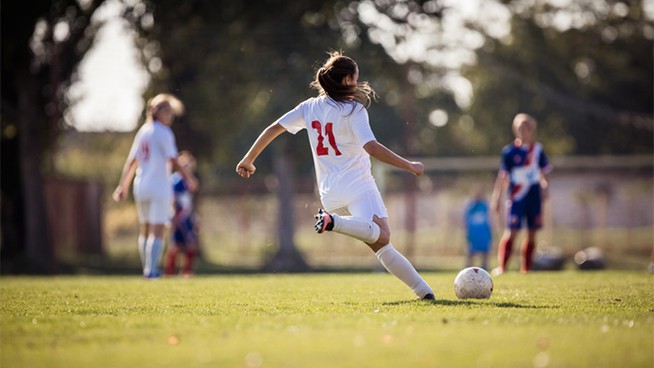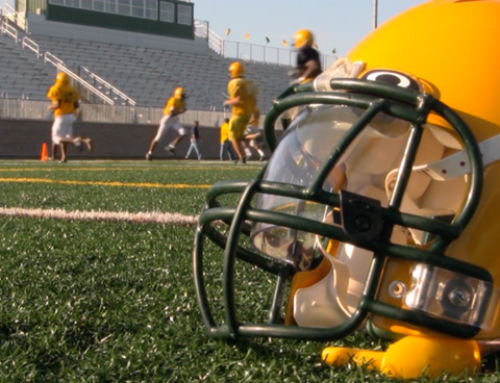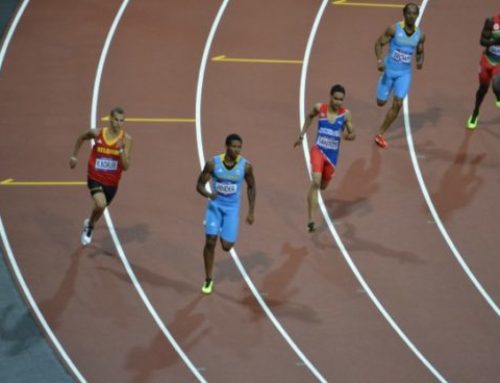5 Core Exercises That Can Make You Faster
If you think of your body as a giant chain, your core is the center link that holds everything together. Without a strong and stable core, power cannot be adequately transferred through the body, and that has a negative impact on performance.
“The more stable your core is, the more easily force is transferred throughout your body,” says Tony Gentilcore, co-founder of Cressey Performance.
The ability to stabilize yourself while driving off one leg, which is the basic motion of running, largely depends on a strong core; and accelerating with a proper body angle is impossible without adequate core strength. A study stated “core strength training has an important role in improving running performance from a physical perspective and proper body angle is impossible without adequate core strength.”
Although strong lower-body muscles like the hamstrings and quads are very important to speed, a weak core can prevent you from reaching your full potential. With that in mind, here are five core exercises that can help you get faster.
Hanging Marches
This one comes from Craig Weller, co-owner of Rogue Performance and Barefoot Fitness. Hanging Marches develop the ability to drive your knees up while keeping your ribs pulled down and your back straight, which is essential to good acceleration mechanics. The big key here is to keep your back straight, preventing the muscles of your lower back from getting overly involved in the movement and keeping the focus on your core.
How to Perform Hanging Marches
- Use a wide grip to hang from a Pull-Up bar.
- Focus on pulling both your ribs and shoulder blades down and your hips underneath you.
- Slowly raise one knee as high as possible without rounding your back.
- Hold the top of the movement for roughly 2 seconds.
- Slowly lower your leg back to the starting position before performing the next rep with the opposite leg.
Sets/Reps: 3×10
RELATED: Get Faster by Improving Your Core Mobility
Dead Bugs
A favorite of renowned spinal researcher Stewart McGill, Dead Bugs develop nearly every part of your core. They challenge your upper abs, lower abs, obliques and deep stabilizing muscles. Dead Bugs require you to move your arm and opposite leg at the same time while using your core for stabilization, which translates well to sprinting. Dead Bugs also require you to tighten your abs so your lower back stays on the floor, which helps you learn how to perform movements without unnecessarily involving the muscles of your lower back, something every athlete can benefit from.
How to Perform Dead Bugs
- Lie on your back with your arms extended in front of your shoulders.
- Bend your hips and knees to a 90-degree angle.
- Tighten your abs and press your lower back into the floor.
- Take a deep breath in and begin to exhale.
- As you exhale, slowly extend your left leg toward the floor and bring your right arm overhead.
- Keep your abs tight and your lower back on the floor as you perform the movement.
- Once your arm is overhead and your leg is a few inches from the ground, slowly return them to the starting position.
- Repeat with your opposite arm and leg, alternating reps until the set is complete.
Sets/Reps: 3×10
Half-Kneeling Cable Chops
This exercise develops your ability to stabilize your core as you push a cable across your body and toward the ground. Unlike basic Crunches, it challenges your core in a way that’s common to many athletic movements. Gentilcore says, “I’m a huge fan of Half-Kneeling Chop and Lift variations. Core training is all about building stability.”
How to Perform Half-Kneeling Cable Chops
- Adjust the cable machine so the pulley is at the highest setting. Place the knee of the leg furthest from the machine on the ground and assume a half-kneeling position.
- Grab either the cable or a rope attachment so your hands are parallel to each other and roughly 16 inches apart.
- Begin the exercise by “chopping” the handle across your body and toward the ground. Focus on keeping your core stable.
- Rotate your shoulders slightly to allow your arms to fully extend at the bottom of the movement.
- Return the handle to the starting position and repeat the movement until the set is complete, then switch sides.
Sets/Reps: 2×8 each side
Half-Kneeling Cable Lifts
These are similar to Half-Kneeling Cable Chops, except that you’re stabilizing your core while moving a weight up instead of down. Both Cable Chops and Cable Lifts engage your hips, which are crucial to speed. “Excessive trunk flexion in response to increased hip flexion is a potential energy leak in the kinetic chain,” says Stephen Gamma, CSCS and certified athletic trainer. Half-Kneeling Cable Lifts work on core stability, hip stability and glute activation.
How to Perform Half-Kneeling Cable Lifts
- Adjust the cable machine so the pulley is at the lowest setting. Place the knee of the leg closest to the machine on the ground and assume a half-kneeling position.
- Grab either the cable itself (as you can see Gamma doing in the above video) or a rope attachment, so your hands are parallel to each other and roughly 16 inches apart.
- Lift the cable across your body while keeping your arms stiff. Focus on keeping your core stable.
- Rotate your shoulders only slightly to allow your arms to reach full extension on the lift.
Sets/Reps: 2×8 each side
Landmine Rainbows
Landline Rainbows require you to use your core for stabilization while you move a weight through a plane of motion. They get their name from the fact that they require you to lift an anchored barbell (also known as a landmine) over your head in a rainbow-like movement. By moving the weight from side to side and over your head, you hit a huge area of your core and simultaneously engage your hips.
How to Perform Landmine Rainbows
- Place a barbell in a landmine rack and load the desired amount of weight (it’s best to start light for this movement).
- Stand directly in front of the end of the barbell and raise it above your head with both hands.
- While keeping your body stationary, move the barbell in a rainbow-like arc. Bend slightly at the elbows while moving the weight, but try not to rotate at the hips or shoulders.
- Stand tall throughout the movement.
Sets/Reps: 3×10
RECOMMENDED FOR YOU
MOST POPULAR
5 Core Exercises That Can Make You Faster
If you think of your body as a giant chain, your core is the center link that holds everything together. Without a strong and stable core, power cannot be adequately transferred through the body, and that has a negative impact on performance.
“The more stable your core is, the more easily force is transferred throughout your body,” says Tony Gentilcore, co-founder of Cressey Performance.
The ability to stabilize yourself while driving off one leg, which is the basic motion of running, largely depends on a strong core; and accelerating with a proper body angle is impossible without adequate core strength. A study stated “core strength training has an important role in improving running performance from a physical perspective and proper body angle is impossible without adequate core strength.”
Although strong lower-body muscles like the hamstrings and quads are very important to speed, a weak core can prevent you from reaching your full potential. With that in mind, here are five core exercises that can help you get faster.
Hanging Marches
This one comes from Craig Weller, co-owner of Rogue Performance and Barefoot Fitness. Hanging Marches develop the ability to drive your knees up while keeping your ribs pulled down and your back straight, which is essential to good acceleration mechanics. The big key here is to keep your back straight, preventing the muscles of your lower back from getting overly involved in the movement and keeping the focus on your core.
How to Perform Hanging Marches
- Use a wide grip to hang from a Pull-Up bar.
- Focus on pulling both your ribs and shoulder blades down and your hips underneath you.
- Slowly raise one knee as high as possible without rounding your back.
- Hold the top of the movement for roughly 2 seconds.
- Slowly lower your leg back to the starting position before performing the next rep with the opposite leg.
Sets/Reps: 3×10
RELATED: Get Faster by Improving Your Core Mobility
Dead Bugs
A favorite of renowned spinal researcher Stewart McGill, Dead Bugs develop nearly every part of your core. They challenge your upper abs, lower abs, obliques and deep stabilizing muscles. Dead Bugs require you to move your arm and opposite leg at the same time while using your core for stabilization, which translates well to sprinting. Dead Bugs also require you to tighten your abs so your lower back stays on the floor, which helps you learn how to perform movements without unnecessarily involving the muscles of your lower back, something every athlete can benefit from.
How to Perform Dead Bugs
- Lie on your back with your arms extended in front of your shoulders.
- Bend your hips and knees to a 90-degree angle.
- Tighten your abs and press your lower back into the floor.
- Take a deep breath in and begin to exhale.
- As you exhale, slowly extend your left leg toward the floor and bring your right arm overhead.
- Keep your abs tight and your lower back on the floor as you perform the movement.
- Once your arm is overhead and your leg is a few inches from the ground, slowly return them to the starting position.
- Repeat with your opposite arm and leg, alternating reps until the set is complete.
Sets/Reps: 3×10
Half-Kneeling Cable Chops
This exercise develops your ability to stabilize your core as you push a cable across your body and toward the ground. Unlike basic Crunches, it challenges your core in a way that’s common to many athletic movements. Gentilcore says, “I’m a huge fan of Half-Kneeling Chop and Lift variations. Core training is all about building stability.”
How to Perform Half-Kneeling Cable Chops
- Adjust the cable machine so the pulley is at the highest setting. Place the knee of the leg furthest from the machine on the ground and assume a half-kneeling position.
- Grab either the cable or a rope attachment so your hands are parallel to each other and roughly 16 inches apart.
- Begin the exercise by “chopping” the handle across your body and toward the ground. Focus on keeping your core stable.
- Rotate your shoulders slightly to allow your arms to fully extend at the bottom of the movement.
- Return the handle to the starting position and repeat the movement until the set is complete, then switch sides.
Sets/Reps: 2×8 each side
Half-Kneeling Cable Lifts
These are similar to Half-Kneeling Cable Chops, except that you’re stabilizing your core while moving a weight up instead of down. Both Cable Chops and Cable Lifts engage your hips, which are crucial to speed. “Excessive trunk flexion in response to increased hip flexion is a potential energy leak in the kinetic chain,” says Stephen Gamma, CSCS and certified athletic trainer. Half-Kneeling Cable Lifts work on core stability, hip stability and glute activation.
How to Perform Half-Kneeling Cable Lifts
- Adjust the cable machine so the pulley is at the lowest setting. Place the knee of the leg closest to the machine on the ground and assume a half-kneeling position.
- Grab either the cable itself (as you can see Gamma doing in the above video) or a rope attachment, so your hands are parallel to each other and roughly 16 inches apart.
- Lift the cable across your body while keeping your arms stiff. Focus on keeping your core stable.
- Rotate your shoulders only slightly to allow your arms to reach full extension on the lift.
Sets/Reps: 2×8 each side
Landmine Rainbows
Landline Rainbows require you to use your core for stabilization while you move a weight through a plane of motion. They get their name from the fact that they require you to lift an anchored barbell (also known as a landmine) over your head in a rainbow-like movement. By moving the weight from side to side and over your head, you hit a huge area of your core and simultaneously engage your hips.
How to Perform Landmine Rainbows
- Place a barbell in a landmine rack and load the desired amount of weight (it’s best to start light for this movement).
- Stand directly in front of the end of the barbell and raise it above your head with both hands.
- While keeping your body stationary, move the barbell in a rainbow-like arc. Bend slightly at the elbows while moving the weight, but try not to rotate at the hips or shoulders.
- Stand tall throughout the movement.
Sets/Reps: 3×10











